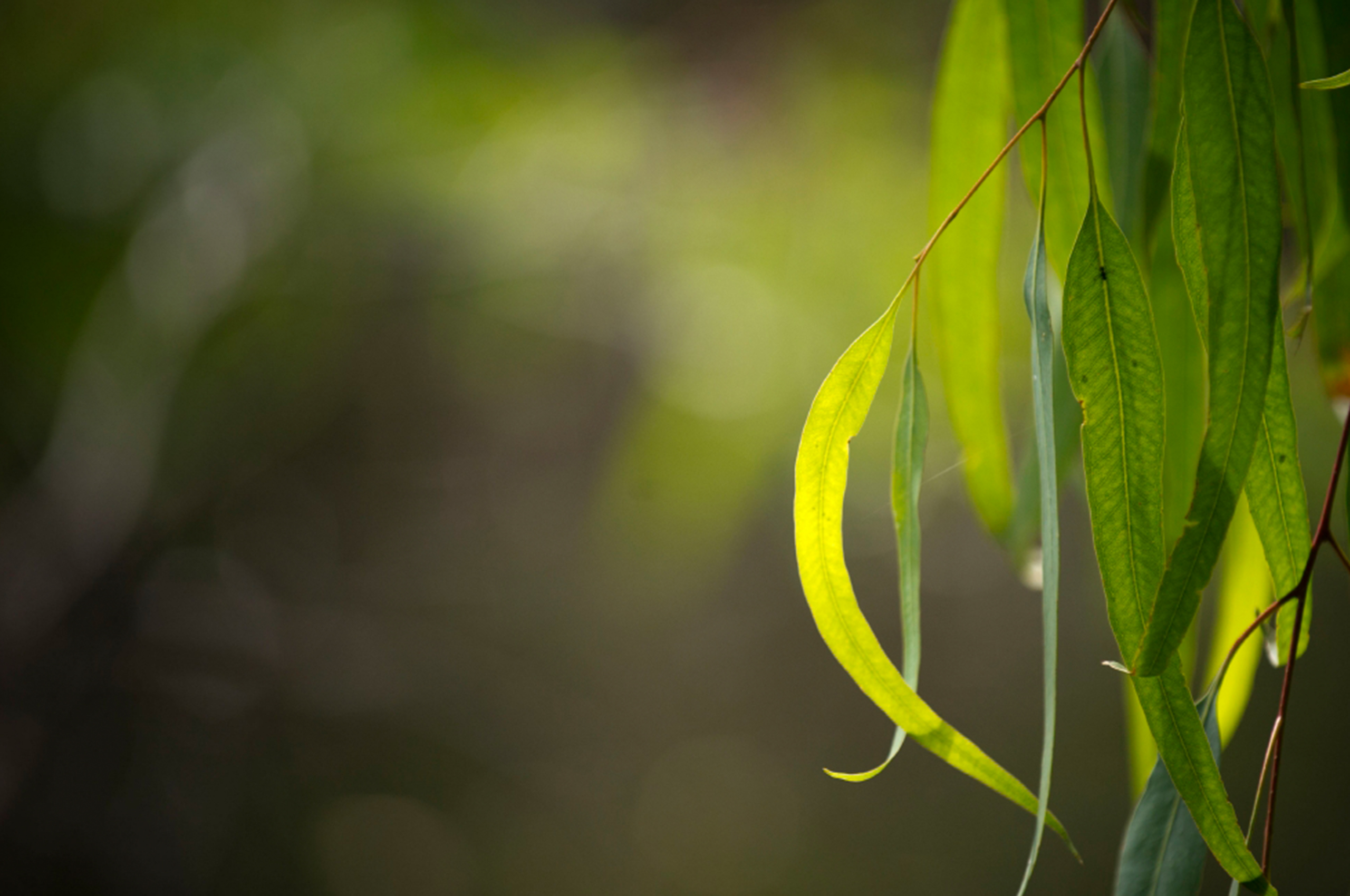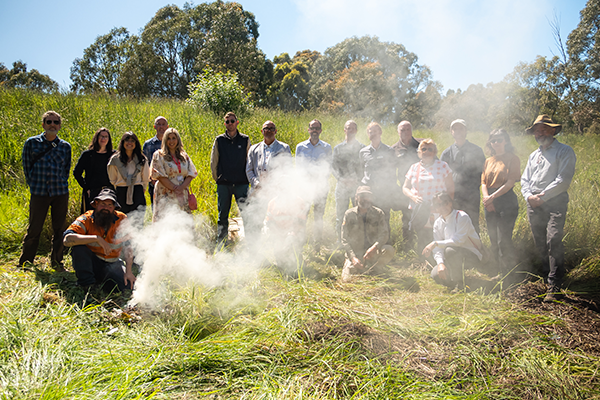Nangak Tamboree

The critically endangered Matted Flax-lily (Dianella amoena) resurfaced along Darebin Creek following the re-introduction of cultural burning.
Over the next decade, La Trobe University is evolving into a world-class University City - a place where the local community are welcomed onto the campus as a place to live, learn, work, socialise and stay healthy.
Nangak Tamboree is a key part of the La Trobe University City.
About the Nangak Tamboree
La Trobe University acknowledges the traditional custodians of the lands where its campuses are located in Victoria. We pay our respects to the Wurundjeri people, the Elders past and present.
Nangak Tamboree (nan-nyack tam-bor-ee) means respecting/sharing/looking after the waterway in Woiwurrung language of the Wurundjeri people.
Nangak Tamboree is a very special space on the Melbourne Campus of La Trobe University. A living laboratory for students, staff and the wider community, its waterways connect with the local creeks, attract wildlife and support native flora.
Nangak Tamboree is a biodiverse waterway corridor which links La Trobe University to the wider community and environment. Connecting with Darebin Creek in the south, it runs through the Bundoora campus to the Wildlife Sanctuary and beyond to the north. A long-term project as part of the University’s Master Plan will see this neighbourhood enhanced and protected over the coming years for the benefit of the University and its neighbours.
During the Spring of 2018, the University engaged with the students, staff and the Indigenous community to name the Nangak Tamboree, creating an identity which reflects its Indigenous heritage. You can explore the map to find out more about the naming campaign.
Nangak Tamboree Vision
The project has, through comprehensive internal and external consultation, established a Vision and a suite of short, medium and long term capital works projects to develop this unique bio-diverse waterway corridor, maximising benefits to the land, the university and the community.
Nangak Tamboree will create an inviting, open and culturally aware space that protects our biodiversity and connects our communities. It will maximise the benefits to the University and its neighbours by:
- Building partnerships: Creating a shared stewardship of this valuable regional asset
- Increasing sustainability and improving biodiversity: setting new standards to protect and enhance the natural environment
- Blurring boundaries: Creating new pathways to travel through and new spaces for everyone to meet, live, study, work and play in
- Improving resilience to severe weather events: remodelling the lakes and moat systems to protect our region from the extremes of flooding and drought
- Educating the community: supporting the delivery of tertiary teaching and research while forging new links with local schools
- Respecting cultural heritage: taking a lead from local custodians of the land and sharing an understanding of the value of our waterways
Download the Nangak Tamboree Vision [PDF 1.54MB]
Our projects
A Flood modelling report, Vision and Feasibility Study (suite of short, medium and long-term capital works projects) were published in January 2018. Five projects will help us to enhance and protect Nangak Tamboree by:
- Creating greater campus amenity
- Reducing risk from severe weather events
- Creating teaching and learning, living laboratories
- Increasing habitat for endemic flora and fauna
- Increasing access to the local community and school students
- Recognising and providing connections for Indigenous staff and students.
Find out more about our projects below.
As part of La Trobe’s long-term commitment to enhance and protect Nangak Tamboree, the full riparian corridor along the waterway is being revegetated over the next 5-10 years.
Phase one of the project, which was completed in December 2022, covered the Darebin Creek frontage and involved regenerating indigenous plant species and managing weed infestation through Wurundjeri Woi-wurrung fire practice and manual weed removal, and revegetating 92,000 m2 with indigenous plant species.
Phase 1 was implemented through a collaboration between Melbourne Water, the Darebin Creek Management Committee, the Wurundjeri Woi-wurrung Cultural Heritage Aboriginal Corporation (WWCHAC) and La Trobe University. This project would like to acknowledge the support of the Ross Trust.
Celebrating the Revegetation of Darebin Creek - November 2022
As part of the project, Darebin Creek Management Committee and Wurundjeri Woi-wurrung Narrap Rangers held cultural burning along the Darebin Creek in November 2022, to help manage weeds and regenerate native plant species.
Wurundjeri Woi-wurrung elder Uncle Dave Wandin performed a Welcome to Country, a smoking ceremony and shared his unique knowledge about how Indigenous fire practice helps to heal the Country. With students from the La Trobe Botany Society, researchers, and community members, the event was a celebration of a collaborative partnership between La Trobe University, Melbourne Water, Darebin Creek Management Committee and the Wurundjeri Woi Wurrung Cultural Heritage Aboriginal Corporation.
This planned burn followed the cultural burn that was conducted earlier this year, which followed the cultural protocols of healing and caring for the Country. Read more about the re-introduction of cultural burning as part of the project and how the critically endangered Matted Flax-lily (Dianella amoena) recently resurfaced along Darebin Creek following the practice.
Protecting the endangered Matted Flax-lily
La Trobe has also been working with the Federal Department of Climate Change, Energy, the Environment and Water to salvage the Matted Flax-lily (Dianella amoena) in the Sports Park project area for propagation and then re-establishment in a dedicated and protected area in the Nangak Tamboree. View the following reports:
- Offset Management Plan
- Salvage and Translocation Plan
- Offset Site Year 1 ecological monitoring report
- Offset Site Year 2 ecological monitoring report
- Offset Site Year 3 ecological monitoring report
Stage 2: June 2021 - December 2021
Stage 2 of the project involved the construction of 24 raingardens in Car Parks 3, 4 and 6 at the Melbourne Campus.
Raingardens work by filtering stormwater through layers of plants, sand, soil and fabric before it flows into the moat and Darebin Creek, thereby improving the quality of the waterway for flora and fauna. Pollutants such as nitrogen and phosphorus, as well as suspended solids and stormwater discharge, are all captured in the raingarden and prevented from entering the waterway.
This project has been assisted by the Victorian Government through Melbourne Water Corporation as part of the Liveable Communities, Liveable Waterways Program.
Stage 1: August 2020 - February 2021
Stage 1 of the project involved the installation of 12 raingardens (biofilter beds) across three car parks at the Melbourne Campus to naturally treat and clean stormwater it before it reaches the moat.
Together with the Fozzies Wetland project, these works will remove pollutants from entering La Trobe’s moat system and flowing into Darebin Creek, including:
- 110 kg of Nitrogen;
- 19 kg of Phosphorus;
- 13,000 kg of suspended solids; and
- 3.6 megalitres of stormwater discharge
This project has been assisted by the Victorian Government through Melbourne Water Corporation as part of the Living Rivers Stormwater Program.
La Trobe created a new shared cycling and pedestrian pathway right through the heart of the Melbourne Campus in Bundoora in October 2022. The opening event was attended by the Hon Lily D’Ambrosio, Minister for Energy, Environment and Climate Action; our local member the Hon Minister Colin Brooks, Minister for Child Protection and Family Services; Cr Lina Messina, Mayor City of Darebin; Professor Jessica Vanderlelie, Deputy Vice-Chancellor (Students), La Trobe University; as well as La Trobe student and staff cyclists.
The new 1.9km shared pathway links Plenty Road and Polaris Shopping Centre at the north of the campus with the Sports Park and Darebin Creek to the south. The pathway is 3-4 metres wide and is available for everyone to use and enjoy – people riding bikes skateboards and scooters, people walking or jogging, and families and children.
It includes lighting and directional and wayfinding signage to provide a safer route for people riding bikes or walking, and to create connections with the surrounding community such as the La Trobe University Melbourne Campus, the Nangak Tamboree Wildlife Sanctuary, local shopping precincts, Darebin Creek Trail and nearby bushland reserves.
The La Trobe Shared Pathway project is part of the Northern Regional Trails Strategy and was supported by the Victorian Government through the Northern Metropolitan Trails Program. The project commenced in late October 2021 and was completed in October 2022.
As part of this project, students studying Archaeology at La Trobe University were involved in site excavations which uncovered more than 40 indigenous stone artefacts near Darebin Creek.
This project involves construction of waterway channel, low level bund and water overflow to divert and direct Strathallan Creek.
In collaboration with Melbourne Water, Darebin City Council, the Department of Environment, Land, Water and Planning, Parks Victoria and Strathallan Golf Club this project aims to improve the environment of the Habitat Link wetlands and reduce the severity of flooding for the Melbourne Campus, holding and diverting flood waters into the Gresswell lakes during incidents of extreme rainfall.
This project is currently in design and has been assisted by the Victorian Government through Melbourne Water Corporation as part of the Integrated Incentives Scheme Program.
The Fozzies Wetland project involved a number of works that will improve the wetland habitat – located at the entrance to the Wildlife Sanctuary – to support environmental improvement.
Works include the removal of weeds and sediment; improving the wetland bund and embankment; improving stormwater capture and reuse; and, providing safer pedestrian access to the Wildlife Sanctuary.
These works are helping to enhance the waterway for a population of endangered native freshwater Galaxias fish living in the wetland.
The project commenced in August 2020 and was completed in February 2021.
This project has been assisted by the Victorian Government through Melbourne Water Corporation as part of the Living Rivers Stormwater Program.
Contact Us
For more information about the Nangak Tamboree projects or the La Trobe University City, get in touch with us.
Project enquiries:
Tony Inglis, Project Director
Infrastructure and Operations, La Trobe University
M: 0417 305 956
E: A.Inglis@latrobe.edu.au









